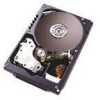IBM IC35L036UWDY10 Hard Drive Specifications - Page 210
Invalid LUN in Identify Message, 1.3 Incorrect Initiator Connection
 |
UPC - 000004119524
View all IBM IC35L036UWDY10 manuals
Add to My Manuals
Save this manual to your list of manuals |
Page 210 highlights
11.1.2 Invalid LUN in Identify Message There are three different circumstances defined within the SCSI protocol when the response to an invalid LUN will occur. Each of these result in a different response. 1.1.1 .1 Case 1 - Selection message sequence with Inquiry command The INQUIRY command is a special case in SCSI. It is used to configure the bus when the drive ID's and LUN's are not known. The proper response is to return the inquiry data with a peripheral drive type of 1Fh which indicates that the specified LUN is not supported. 1.1.1 .1 Case 2 - Selection message sequence with any other command Any other commands except REQUEST SENSE return CHECK CONDITION status when an invalid LUN is specified in the message sequence following selection. In response to a REQUEST SENSE command the drive shall return sense data. The sense key shall be set to ILLEGAL REQUEST and the additional sense code shall be set to LOGICAL UNIT NOT SUPPORTED. 11.1.2 .1 Case 3 - After selection message sequence It is permissible for the initiator to issue multiple IDENTIFY messages during a single command sequence provided the LUN remains the same. If the LUN is altered, the drive goes to a BUS FREE Phase. 11.1.3 Incorrect Initiator Connection Incorrect Initiator Connection error is reported if any of the following conditions occur: ! an Initiator attempts to establish an I_T_L nexus when an I/O process (either queued or active) with an I_T_L nexus already exists from a previous connection with the same initiator. ! an Initiator attempts to establish an I_T_L_Q nexus when an I/O process (either queued or active) with an I_T_L_Q nexus already exists from a previous connection with the same initiator. Note: It is not an Incorrect Initiator Connection to attempt to establish an I_T_L nexus when an I_T_L_Q nexus already exists or establish an I_T_L_Q nexus when an I_T_L nexus already exists. But when sense is pending on the logical unit for the initiator and send command is not REQUEST SENSE, INQUIRY or REPORT LUNS, sense data is cleared upon receipt of the command. If any of the above errors occur, all queued I/O processes and active I/O processes associated with the issuing Initiator on the specified logical unit are terminated. The current I/O process is ended with a CHECK CONDITION status, the sense key is set to ABORTED COMMAND, and the additional sense code is set to OVERLAPPED COMMANDS ATTEMPTED. Status is only returned for the current I/O process. 11.1.4 Command Processing during execution of active I/O process When the Target is not executing any active I/O processes, a new I/O process is permitted to execute unless execution is prevented by another internal Target condition listed in Section 11.1.1 , "Priority of SCSI Status Byte Reporting" on page 193. If an active I/O process does exist when the Target receives a new command, the Target determines how the new command should be handled based on the following rules: ! CHECK CONDITION Status is returned with Sense Key set to ABORTED COMMAND for an Incorrect Initiator Connector Condition error. See 11.1.3, "Incorrect Initiator Connection." ! the command is permitted to execute if the command is an INQUIRY, REQUEST SENSE, or REPORT LUNS command ! CHECK CONDITION Status is returned with Sense Key set to Logical Unit Not Ready if the bringup operation or format operation is an active process. Ultrastar 146Z10 hard disk drive specifications 194















